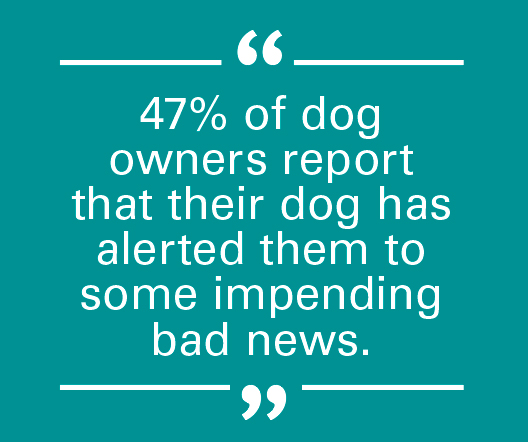

Can Dogs See Spirits or Sense Ghosts?
What about Hallucinations?
Can dogs see spirits? It seems that one of the oldest and most persistent paranormal beliefs is that dogs have the ability to see spirits, ghosts of the dead, and other supernatural beings. The dog usually signals that such uncanny things are close by howling or breaking the silence of the night with a mournful series of widely spaced barks, or acting in a skittish, fearful manner. Some scholars trace these beliefs back to ancient Egypt, where the god of the dead was Anubis. He was even represented as having the head of the dog, and it was felt that a dog howling in the night was calling a soul sensed nearby to Anubis.
In Ireland the belief is that dogs can hear the noise of the spectral hounds that lead ghostly riders on their wild hunt through the sky, collecting the souls of the dying. My favourite, though, is the ancient Norse legend which speaks of the goddess Freya. She was the bearer of love, fertility, and magic, but was also the goddess of death. She rides the crest of the storm on her chariot pulled by giant cats. Because cats are dogs' natural enemies it is said that dogs start to howl or bark when they sense the approach of this supernatural being and her mystical felines.
The belief that dogs are in tune with the spirit world or have some sort of precognition which allows them to anticipate ominous events is not just something from the distant past; it persists in our modern day. For example, the Associated Press had a public affairs and corporate communications group conduct what they called a Petside Poll, which involved telephone interviews of 1000 pet owners in the US. Among other things, this survey found that 47 percent of dog owners report that at some time or another their dog has alerted them to some impending bad news. The dog's reported alerting involves behaviours like trying to hide in a safe place, whining or whimpering, hyperactive or erratic behaviour, or barking persistently just prior to something dire happening.

Then there are the many anecdotes which describe dogs who appear to be sensitive to ghosts or even places associated with death. One of these was related to me some time ago by a colleague in the Department of Mathematics at my university. Before the real estate market in our area heated up, he had been lucky enough to be able to afford a small house which overlooked the water not far from the university campus. At that time he had a Labrador Retriever named Lambda. When the weather permitted he would walk the dog along one of the many nearby paths which wend their way down the steep embankment to the sandy shore below. Lambda always loved such walks, scouting out in front and happily exploring the terrain on either side of the trail. That was the case for all of the paths to the beach except one. Whenever my colleague chose to walk the dog along that particular pathway to the shore, something strange would happen. About midway down the trail Lambda would freeze. He would stare into the bush and produce a strange growl which seemed to be mixed with warbling whimpers. The only way that he could get Lambda to move past this point was to grab hold of his collar and physically tug him several yards along the path until he was well away from that place. The reason that my colleague felt that describing Lambda’s behaviour might be interesting to me was because he later learned that it was exactly at that same place, on that same trail, where a few years before a student had been found dead. The student's death was ambiguous and whether it was by accident or foul play had never been determined. My colleague became convinced that somehow or another Lambda was sensing the ghost or spirit of that unfortunate young woman and it was an extrasensory awareness of the sad spirit which provoked the dog's odd and worried behaviour.
Being the kind of scientific skeptic that I am, I am more inclined to interpret such behaviours in a way that does not involve the paranormal. Dogs have keener senses than we do, especially when it comes to smell and hearing. Many dogs are also reactive to unexpected visual events such as moving or ambiguous shadows. I am of the belief that many of the instances in which dogs are believed to be alerting to ghosts or spirits are simply situations where the dog senses something through his normal sensory channels which the average human cannot. Whatever the dog is perceiving in such cases is vague and uncertain to him. In the absence of a clear idea of what he is sensing the dog tends to become wary and acts in a cautious or suspicious manner. It is this insecure response in situations where nothing is visible to the human eye that people interpret as being a reaction to the presence of some kind of spirit.
Whether or not dogs can actually detect ghosts, it is interesting to note that canines can actually be used to detect another kind of sensory event which may be troublesome and disturbing and is also invisible to people observing the situation—namely hallucinations. A hallucination is a perception which occurs even though there is no kind of actual stimulus or physical event present. For the person having a hallucination, what they are perceiving seems real, and whatever they see or hear appears to be located in the real world. This is different from dreaming, or imagery, in which we might have vivid images but we are also aware that these images don't represent something that actually exists outside of our mind. Although hallucinations can occur in any one of our senses, it is when they involve visual images or are linked to sounds that we believe we are hearing that they can be most disturbing.

More commonly, particularly disquieting hallucinations can also occur in individuals with major stress-related psychological problems such as PTSD. In such cases the hallucinations are often related to aspects of the traumatic situations which caused the patient's problem in the first place. Thus a veteran returning from combat might have hallucinations in which there is an armed and threatening person that he can vaguely see or hear nearby. On the other hand a rape victim might think that she sees a person who is a potential sexual predator trying to hide in the room that she was about to enter. Sometimes these stress-related hallucinations indicating that there is some malicious person nearby occur when the patient is in a hypnagogic state, which is that dream-like state of mind that occurs just before falling asleep. Such hallucinations can be very unsettling, and can trigger strong anxieties which can then in turn produce bouts of severe fearfulness or panic attacks.
It is here, when dealing with a person suffering from such hallucinations, that dogs become incredibly valuable. Psychiatric service dogs are often specifically trained to deal with this kind of problem. For example, where the person with the psychological difficulty seems to sense that someone is hiding in their bedroom, the dog can be trained to search the room and sound an alert if anybody is present. Generally speaking, when the dog indicates that there is no one lurking about, this gives the patient a sense of confidence, reduces their stress level and allows them to proceed with the normal course of their life.
However, these psychiatric service dogs can also be used to detect full blown hallucinations, such as those that seem to indicate that there is a someone with dangerous motives or threatening intentions close by. In this case the training required of the dog is rather simple. The dog is taught to respond to a command, such as “Go say hello!,” which is accompanied by the dog's owner pointing in a particular direction. If there is a person actually present the dog is supposed to respond by going out in that direction and making an attempt to greet and interact with whoever is there. If there is no one physically present then the dog is trained either to sit quietly while looking in the direction indicated, or sometimes to give a short bark to indicate that they sense nothing. If the dog indicates that there is no one actually present, then the patient immediately knows that what they are dealing with is a sensory hallucination and there is nothing to worry about. Knowing that there is no threat generally serves to greatly relieve the person suffering from this kind of psychological problem. Gaining the insight that the menacing presence that the patient is experiencing does not really exist tends to ratchet down the person's stress level and allows the individual to continue functioning without fear or anxiety.
So although the question of whether dogs can detect ghosts or spirits may still be debated by some people, it is certainly the case that dogs can alert people to the existence of hallucinations. They do this by indicating that, even with their superior senses, they do not detect anything is present, offering a clear signal that the danger that their owner perceives is not authentic and they are safe.
So, can dogs see spirits? Still, despite my scientific training, in the dark of the night it sometimes gives me comfort to feel that my dogs might warn me if they sense the coming of the death-dealing goddess Freya and her flying chariot pulled by huge supernatural cats.
Join the newsletter and never miss out on dog content again!
"*" indicates required fields
By clicking the arrow, you agree to our web Terms of Use and Privacy & Cookie Policy. Easy unsubscribe links are provided in every email.